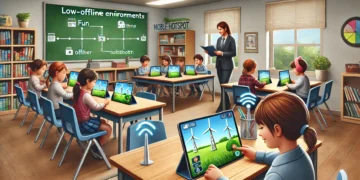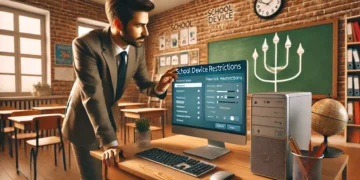Let’s face it — in today’s world, if you’re not editing video, you’re probably watching one. Whether you’re a teacher jazzing up lesson content or a student trying to turn a group project into something tolerable, video editing is a skill that’s becoming just as essential as knowing how to mute your mic on Zoom.
But once you’ve got your footage, the big decision looms: do you whip out your phone and start slicing clips in a café, or do you settle in at your desk like a digital wizard with dual monitors and a snack drawer? In other words — should you go mobile or stick with desktop?
The Showdown: Mobile vs Desktop Editing
 Think of mobile and desktop editing like fast food vs gourmet cooking. One gets the job done quick and tasty, the other gives you full control over every ingredient — but takes longer and might require a bit of a mess (and probably a software update or two).
Think of mobile and desktop editing like fast food vs gourmet cooking. One gets the job done quick and tasty, the other gives you full control over every ingredient — but takes longer and might require a bit of a mess (and probably a software update or two).
On mobile, you’ve got access to quick, lightweight tools, ideal for those hit-and-run style edits on your lunch break. Desktop setups, on the other hand, let you go deep — we’re talking about layered timelines, audio mixing, and smooth transitions.
For teachers and students alike, understanding the strengths and quirks of both platforms can help you pick the right Edtech tool for the task, whether it’s explaining the water cycle or filming your next history project as a mockumentary.
Mobile Video Editing: Light, Fast, and in Your Pocket
 Now, let’s discuss mobile video editing a little bit more.
Now, let’s discuss mobile video editing a little bit more.
Pros
- It’s portable: Your phone is always with you, which means your video studio is, too. Shot a field trip? A how-to baking demo for class? Fire up a mobile video editing app and get cracking on edits before the school bell rings.
- User-friendly: Most mobile editing apps are built for humans — not for robots with degrees in video production. Drag, tap, swipe, done. You don’t need to know what keyframing is to make something look cool.
- Great for short-form content: If you’re making TikToks, Reels, or YouTube Shorts, mobile editing is perfect for you. Add music, effects, and text overlays in minutes. It’s ideal for turning everyday clips into share-worthy magic.
- Free doesn’t mean bad: Some of the best editing apps out there are totally free. Seriously. Your next viral video could be made on an app that costs less than your iced coffee. Not bad for a free video editor, right?
Cons
- Tiny screen, tiny patience: Editing a five-minute video on a six-inch screen? It’s like doing surgery with oven mitts. It can be done, but you’ll need zen-level focus — and probably a phone stand.
- Limited power: Mobile devices aren’t built for 4K timelines with 10 audio tracks. Add a few layers and your app might start acting like it’s more tired than you after a whole day of work.
- Storage chaos: Video files take up a lot of space. Before you know it, you will have to delete some old selfies or memorable videos to make room.
- Precision isn’t its thing: Want frame-perfect cuts or advanced color grading? You’ll miss the accuracy of a mouse and a full-size interface. Mobile is great for fast edits, not fine-tuned perfection.
Desktop Video Editing: Power, Control, and Pro Features
 Let’s also take a look at the benefits desktop video editing can provide.
Let’s also take a look at the benefits desktop video editing can provide.
Pros
- Big tools for big projects: Video editing on PC means you’re playing with the big toys. Think multi-track editing, advanced transitions, and enough export options to make your head spin — in a good way.
- More screen: Having a full display (or two) means less guesswork and more room to organize your timeline, audio levels, and clips. It’s a game-changer, especially for teachers building instructional videos or students editing class documentaries.
- Advanced features: Want to key out a green screen? Add a voiceover? Stabilize shaky footage from your science fair vlog? That’s all possible — and smoother — with desktop software.
- It plays nice with others: Desktop editors are best friends with external drives, microphones, and all the other gear you might use. That means a better basic editing workflow for more complex projects.
Cons
- A bit of a learning curve: These programs are powerful — but they don’t hold your hand. Expect to spend some time on YouTube tutorials.
- It’ll cost you: While there are great free tools, the high-end stuff can feel like you’re renting software just to be confused by it.
- You’re not going anywhere: Desktop setups aren’t exactly portable. Unless you’re lugging around a gaming laptop, you’ll need to do your editing in one place.
- Hardware matters: Got an old laptop that struggles every time you open Chrome? It’s probably going to throw a tantrum with Windows editing software. Fast processors and enough RAM are your friends here.
So, Which One Should You Use?
 Now that we’ve covered advantages and disadvantages of both video editing types, it’s time to answer the most important question: which one will be better for you?
Now that we’ve covered advantages and disadvantages of both video editing types, it’s time to answer the most important question: which one will be better for you?
For Quick, Simple Projects and Social Content
 If you’re mostly editing short-form content, like vertical videos for social media or simple clips for student presentations, mobile video editing apps are more than enough. They’re fast, intuitive, and ideal for time-sensitive projects.
If you’re mostly editing short-form content, like vertical videos for social media or simple clips for student presentations, mobile video editing apps are more than enough. They’re fast, intuitive, and ideal for time-sensitive projects.
You can even go one step further by exploring InShot download for PC using an android emulator, giving you mobile-level editing tools on your computer — a handy hybrid approach for those who like mobile apps but want to work on a bigger screen.
For Long-Form Videos and Polished Productions
 If you’re editing a full lecture series, documentary, or promotional school content, then video editing on PC will give you the control and quality you need. The workflow is better suited for larger files, complex edits, and higher output standards.
If you’re editing a full lecture series, documentary, or promotional school content, then video editing on PC will give you the control and quality you need. The workflow is better suited for larger files, complex edits, and higher output standards.
Plus, for teachers creating professional-level instructional videos, or students learning the fundamentals of digital media, desktop platforms offer the kind of experience that builds real-world skills.
The Hybrid Workflow
 Here’s a not-so-secret secret: a lot of pros mix both. They shoot and rough-cut on mobile (it’s fast and fun), then polish on desktop when they want to level up. This hybrid approach gives you flexibility without sacrificing quality — and it works beautifully in classrooms, where students can collaborate and divide tasks across devices.
Here’s a not-so-secret secret: a lot of pros mix both. They shoot and rough-cut on mobile (it’s fast and fun), then polish on desktop when they want to level up. This hybrid approach gives you flexibility without sacrificing quality — and it works beautifully in classrooms, where students can collaborate and divide tasks across devices.
A teacher might start outlining a video using desktop photo editing tools for visuals, while students film scenes and edit a first cut on mobile. Later, everything comes together on a desktop for the final export. It’s like teamwork — but with transitions and royalty-free music.
Final Thoughts
In the battle of mobile vs desktop video editing, there’s no one-size-fits-all winner. Mobile is fast, friendly, and ideal for short-form creativity. Desktop gives you muscle, precision, and a pro-level finish.
So whether you’re an educator shaping digital lessons or a student turning your homework into a masterpiece, the real magic isn’t in the platform — it’s in how you use it.
Start with the tools that match your current goals, explore what works, and don’t be afraid to combine both. After all, every great editor started somewhere — and probably struggled with exporting settings, just like the rest of us.



























